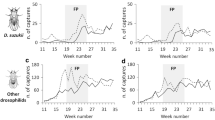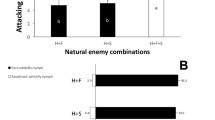Abstract
Augmentative releases of the tachinidLixophaga diatraeae (Townsend) at 3 plantations in south Louisiana at 3 rates [\(\bar X = control\) (none), 119–129 (light), and 796–924 (heavy) mated Φ/ha] resulted in an average of 25% parasitization byL. diatraeae of 1st-generation larvae of the sugarcane borer,Diatraea saccharalis (F.), in all plots. Therefore, parasite dispersal apparently negated rate effects, and results within plantations were pooled.
L. diatraeae parasitized 4th-or-later stage larvae most often and seldom parasitized 1st-or-2nd stage larvae; no pupae produced a parasite. Only 7% of the parasitized larvae collected produced more than 1L. diatraeae parasite.
The average rate of parasitization byL. diatraeae after the releases was 4.1% at Georgia, 8.7% at Raceland, and 35.7% at Gayosa. During this same period, parasitism by a natural population ofAgathis stigmaterus (Cresson) was 11.9% at Georgia, 3.2% at Gayosa, and 2.6% at Raceland. Parasitism byL. diatraeae andA. stigmaterus plus other factors, such as cultivars and field isolation caused the average number of unparasitized borer larvae per ha to be 1.8–3.2 times higher at Georgia and Raceland Plantations, respectively, than at Gayosa Plantation. Nevertheless, the economic injury threshold, the point at which insecticides are applied, was exceeded at Gayosa as well as the other 2 plantations.
Résumé
Des lâchers additionnels de la tachinaireLixophaga diatraeae (Townsend) dans 3 plantations du sud de la Louisiane à 3 taux [

(0), 119–129 (dose faible) et 796–924 (dose forte) femelles accouplées/ha] ont abouti à une moyenne de 25% de parasitisme parL. diatraeae de la 1re génération du foreur de la canne à sucre,Diatraeae saccharalis (F.) dans toutes les parcelles. La dispersion du parasite a donc apparemment effacé l'effet des taux de lâchers et les résultats à l'intérieur des plantations ont été mélangés.
L. diatraeae parasite le plus souvent les larves du 4e ou du dernier stade et rarement celles du 1er ou 2e stade; aucune chrysalide n'a donné de parasites. Seulement 7% des larves parasitées collectées ont produit plus de 1L. diatraeae. Le taux moyen de parasitisme parL. diatraeae après les lâchers fut de 4,1% à Georgia, 8,7% à Raceland et 35,7% à Gayosa. Pendant la même période le parasitisme par une population naturelle deAgathis stigmaterus (Cresson) a été de 11,9% à Georgia, 3,2% à Gayosa et 2,6% à Raceland. Le parasitisme parL. diatraeae etA. stigmaterus, plus d'autres facteurs tels que la nature des cultivars et l'isolement des champs de canne, ont été à l'origine du fait que le nombre moyen à l'ha de larves non parasitées fut de 1,8 et 3,2 fois plus élevé dans les plantations de Georgia et de Raceland, respectivement, que dans celle de Gayosa. Néanmoins le seuil de nuisibilité économique, qui détermine les traitements insecticides, fut dépassé à Gayosa de même que dans les 2 autres plantations.
Similar content being viewed by others
References
Bennett, F. D. — 1969. Tachinid flies as a biological control agent for sugarcane moth borers. In: Pests of Sugarcane (J. R. Williams, J. R. Metcalf, R. W. Mungomery &R. Mathes, eds). —Elsevier Publ. Co., New York, 668 pp.
Boedijono, W. A. — 1974. An attempt to control sugarcane stemborers with the dipterous parasiteDiatraeophaga striatalis (Towns.). —Proc. Int. Soc. Sugarcane Technol., 15, 393–396.
Bonfils, J. &Galichet, P. F. — 1974. Effets d'introductions renouvelées deLixophaga diatraeae [Diptera, Tachinidae] sur des populations naturelles du parasite et de son hôte,Diatraea saccharalis. —Entomophaga, 19, 67–73.
Brewer, F. D. &King, E. G. — 1978. Effects of parasitism by a tachninid,Lixophaga diatraeae, on growth and food consumption of sugarcane borer larvae. —Ann. Entomol. Soc. Am., 71, 19–22.
Charpentier, L. J., Gifford, J. R. & Mathes, R. — 1967. Present status of biological control of the sugarcane borer in continental United States. —Proc. Int. Soc. Sugarcane Technol., 1287–1294.
Hensley, S. D. — 1971. Management of sugarcane borer populations in Louisiana, a decade of change. —Entomophaga, 16, 133–146.
Hensley, S. D., Fanguy, H. P. & Giamalva, M. J. — 1978. The role of varietal resistance in control of the sugarcane borer,Diatraeae saccharalis (F.) in Louisiana —Proc. Int. Soc. Sugarcane Technol., 517–522.
King, E. G., Brewer, F. D. &Martin, D. F. — 1975. Development ofDiatraea saccharalis [Lep.: Pyralidae] at constant temperatures. —Entomophaga, 20, 301–306.
King, E. G., Miles, L. R. &Martin, D. F. — 1976. Some effects of superparasitism byLixophaga diatraeae of sugarcane borer in the laboratory. —Entomol. Exp. Appl., 20, 261–269.
King, E. G., Hartley, G. G., Martin, D. F., Smith, J. W., Summers, T. E. & Jackson, R. D. — 1979. Production of the tachinidLixophaga diatraeae on its natural host, the sugarcane borer, and on an unnatural host, the greater was moth. —U.S.D.A., S.E.A., Adv. Agric. Technol., Southern Series, No. 3, 16 pp.
Knipling, E. F. — 1972. Simulated population models to appraise the potential for suppressing sugarcane borer populations by strategic release of the parasiteLixophaga diatraeae. —Environ. Entomol., 1, 1–6.
Long, W. H., &Hensley, S. D. — 1972. Insect pests of sugarcane. —Annu. Rev. Entomol., 17, 149–176.
Miles, L. R. &King, E. G. — 1975. Development of the tachinid parasiteLixophaga diatraeae, on various developmental stages of the sugarcane borer in the laboratory. —Environ. Entomol., 4, 811–814.
McPherson, R. M. &Hensley, S. D. — 1976. Potential ofLixophaga diatraeae for control ofDiatreaea saccharalis in Louisiana. —J. Econ. Entomol., 69, 215–218.
Montes, M. — 1970. Estudios sobre bionomia v la biometria deLixophaga diatraeae (Towns).[Diptera, Tachinidae]. — Cien. Biol., 4, 60 pp.
Roth, J. P., King, E. G. &Thompson, A. C. — 1978. Host location behavior by the tachnind,Lixophaga diatraeae. —Environ. Entomol., 7, 794–798.
Scaramuzza, L. C. — 1930. Preliminary report on a study of the biology ofLixophaga diatraeae Tns. —J. Econ. Entomol., 23, 999–1004.
Summers, T. E. &Jackson, R. D. — 1973. Demonstrated and potential control of the sugarcane borer in Florida by the Cuba fly,Lixophaga diatraeae. —Proc. Am. Sugarcane Technol., 2, 36 (Abstract).
Summers, T. E., King, E. G., Martin, D. F. &Jackson, R. D. — 1976. Biological control ofDiatraea saccharalis in Florida by periodic releases ofLixophaga diatraeae. —Entomophaga, 4, 359–66.
Teran, F. O. & Novaretti, W. R. — 1978. Management of populations ofDiatraea saccharalis (Fabr., 1974) [Lepidoptera: Crambidae] in sugarcane fields of Sao Paulo, Brazil.Proc. Int. Soc. Sugarcane Technol., 671–687.
Vinson, S. B. — 1976. Behavioral chemicals in the augmentation of natural enemies. In: Biological Control by Augmentation of Natural Enemies (R. L. Ridgway &S. B. Vinson, eds). —Plenum Press, New York & London, 480 pp.
Author information
Authors and Affiliations
Additional information
In cooperation with the Mississippi Agricultural Forestry Experiment Station, Stoneville and the Louisiana Agricultural Experiment Station. Formerly at U.S. Sugarcane Station, Houma, LA 70360, now 1400 Levee Drive, Houma, LA 70360.
Rights and permissions
About this article
Cite this article
King, E.G., Sanford, J., Smith, J.W. et al. Augmentative release ofLixophaga diatraeae [Dip.: Tachnidae] for suppression of early-season sugarcane borer populations in Louisiana. Entomophaga 26, 59–69 (1981). https://doi.org/10.1007/BF02371834
Issue Date:
DOI: https://doi.org/10.1007/BF02371834




